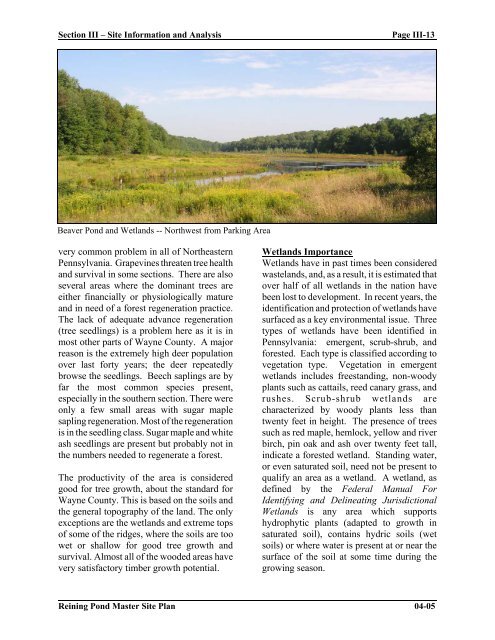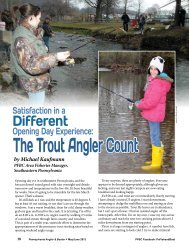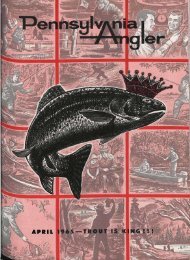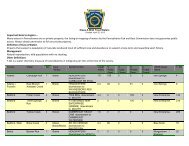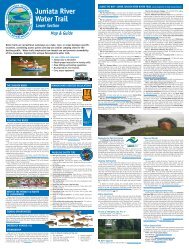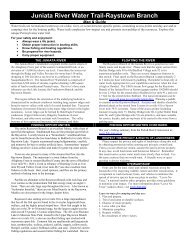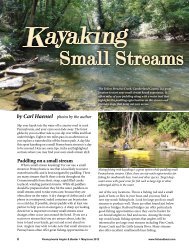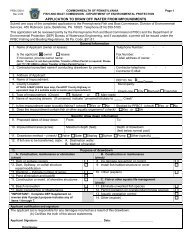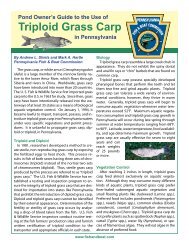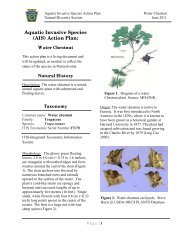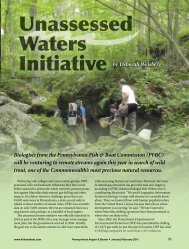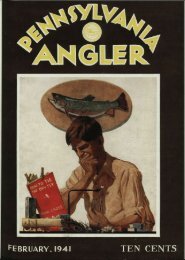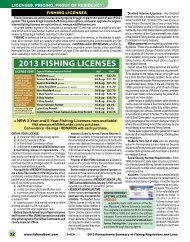Complete report - Pennsylvania Fish and Boat Commission
Complete report - Pennsylvania Fish and Boat Commission
Complete report - Pennsylvania Fish and Boat Commission
You also want an ePaper? Increase the reach of your titles
YUMPU automatically turns print PDFs into web optimized ePapers that Google loves.
Section III – Site Information <strong>and</strong> Analysis Page III-13<br />
Beaver Pond <strong>and</strong> Wetl<strong>and</strong>s -- Northwest from Parking Area<br />
very common problem in all of Northeastern<br />
<strong>Pennsylvania</strong>. Grapevines threaten tree health<br />
<strong>and</strong> survival in some sections. There are also<br />
several areas where the dominant trees are<br />
either financially or physiologically mature<br />
<strong>and</strong> in need of a forest regeneration practice.<br />
The lack of adequate advance regeneration<br />
(tree seedlings) is a problem here as it is in<br />
most other parts of Wayne County. A major<br />
reason is the extremely high deer population<br />
over last forty years; the deer repeatedly<br />
browse the seedlings. Beech saplings are by<br />
far the most common species present,<br />
especially in the southern section. There were<br />
only a few small areas with sugar maple<br />
sapling regeneration. Most of the regeneration<br />
is in the seedling class. Sugar maple <strong>and</strong> white<br />
ash seedlings are present but probably not in<br />
the numbers needed to regenerate a forest.<br />
The productivity of the area is considered<br />
good for tree growth, about the st<strong>and</strong>ard for<br />
Wayne County. This is based on the soils <strong>and</strong><br />
the general topography of the l<strong>and</strong>. The only<br />
exceptions are the wetl<strong>and</strong>s <strong>and</strong> extreme tops<br />
of some of the ridges, where the soils are too<br />
wet or shallow for good tree growth <strong>and</strong><br />
survival. Almost all of the wooded areas have<br />
very satisfactory timber growth potential.<br />
Wetl<strong>and</strong>s Importance<br />
Wetl<strong>and</strong>s have in past times been considered<br />
wastel<strong>and</strong>s, <strong>and</strong>, as a result, it is estimated that<br />
over half of all wetl<strong>and</strong>s in the nation have<br />
been lost to development. In recent years, the<br />
identification <strong>and</strong> protection of wetl<strong>and</strong>s have<br />
surfaced as a key environmental issue. Three<br />
types of wetl<strong>and</strong>s have been identified in<br />
<strong>Pennsylvania</strong>: emergent, scrub-shrub, <strong>and</strong><br />
forested. Each type is classified according to<br />
vegetation type. Vegetation in emergent<br />
wetl<strong>and</strong>s includes freest<strong>and</strong>ing, non-woody<br />
plants such as cattails, reed canary grass, <strong>and</strong><br />
rushes. Scrub-shrub wetl<strong>and</strong>s are<br />
characterized by woody plants less than<br />
twenty feet in height. The presence of trees<br />
such as red maple, hemlock, yellow <strong>and</strong> river<br />
birch, pin oak <strong>and</strong> ash over twenty feet tall,<br />
indicate a forested wetl<strong>and</strong>. St<strong>and</strong>ing water,<br />
or even saturated soil, need not be present to<br />
qualify an area as a wetl<strong>and</strong>. A wetl<strong>and</strong>, as<br />
defined by the Federal Manual For<br />
Identifying <strong>and</strong> Delineating Jurisdictional<br />
Wetl<strong>and</strong>s is any area which supports<br />
hydrophytic plants (adapted to growth in<br />
saturated soil), contains hydric soils (wet<br />
soils) or where water is present at or near the<br />
surface of the soil at some time during the<br />
growing season.<br />
Reining Pond Master Site Plan 04-05


